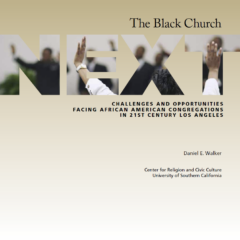Like Ezekiel of old, Dr. Daniel Walker invites us to walk with him through a valley of dry bones. It is not yet a graveyard, but the site of a recent battle between two opposing armies that have abandoned the battlefield without taking time to bury the dead.
Then from above we hear the clarion voice of God asking the bewildered prophet, “Son of dust, can these bones live?” This same question is addressed to the present generation of faith-based leadership, as we struggle to reclaim a legacy that throughout history is threatened with annihilation due to unchanging adaptation to changing times. Can we find a way to connect the bones, the dots, so that we may have a new life transferring us into a new century?
Dr. Daniel Walker, historian, grapples with the question using one segment of the warrior enclave, seasoned veterans of three centuries of struggling for life, liberty, and the pursuit of happiness: the Black Church. Can the Black Church reinvent itself and adapt to a different time, generation, and culture—or is the Black Church dead?
The author knows that the American shores are open to every belief system on the planet, so you can’t paint them all with an ebony brush. He also knows that in the valley of despair the skeletons may be different, but under the skin all people are kin. We all have the same bone marrow making the same blood, and in deficit we all benefit from a new blood transfusion. In each body of faith, we have dry bones to connect and to enliven from the dust of yesterday.
So with all others in the paradigm, the Black Church will be redeemed by sending forth ruach, the wind, the breath of God, the same essence that gave us original life in Adam and the resurrection of life in Jesus.
So let us walk with Dr. Daniel Walker, and talk with God our Father as we dialogue with the question from the Black Church segment of the battlefield: Can these bones live?
Cecil Murray is retired from the USC Center for Religion and Civic Culture.


